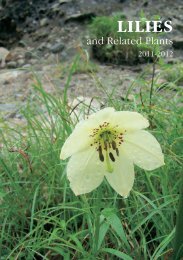LILIES - RHS Lily Group
LILIES - RHS Lily Group
LILIES - RHS Lily Group
You also want an ePaper? Increase the reach of your titles
YUMPU automatically turns print PDFs into web optimized ePapers that Google loves.
ulbs soon. I have seen this lily growing and in flower in sub-alpine woodland<br />
and also in open pastureland in the Italian Dolomites on the Pordoi Pass and<br />
near Arabba. A Swiss member of the <strong>Lily</strong> <strong>Group</strong>, Pontus Wallstén, reports seeing<br />
it growing on wasteland near his home on the edge of Lake Geneva. In White’s<br />
time this lily was also known as Lilium aurantiacum.<br />
Lilium candidum<br />
When I was Editor of the <strong>Lily</strong> <strong>Group</strong>’s Newsletter I asked Geoffrey Smith if he<br />
would write an article for me on lilies. Presenter of BBC TV Gardeners World<br />
in the 1980’s and BBC TV World of Flowers, Panellist on BBC Radio Gardeners’<br />
Question Time for 20 years and horticultural and gardening writer I knew<br />
Geoffrey would write an inspirational article and I was not disappointed. Many<br />
of us will have been inspired by Geoffrey’s passion for gardening and it will not<br />
come as a surprise that lilies are one of his favourite flowers.<br />
He went to North America to make programmes for the World of Flowers with<br />
Ed McRae one of North America’s foremost lily growers. As part of the article<br />
Geoffrey wrote: “In the first century A.D. Pliny the Elder wrote in his “Natural<br />
History” “next to the rose there is no fairer flower or one of greater estimation<br />
than the lily”. Though some might argue with that statement certainly after seeing<br />
the “Madonna” lily, Lilium candidum, growing in rock crevices on a sun-baked<br />
hillside in Northern Greece, an experience surely Pliny must have enjoyed, I<br />
would count the rose and the lily as equals.”<br />
Writing about the Madonna <strong>Lily</strong> in the Modern Herbal Mrs Grieve writes:<br />
“Medicinal Action and Uses; Demulcent, astringent. Owing to their highly<br />
mucilaginous properties, the bulbs are chiefly employed externally, boiled in milk<br />
or water, as emollient cataplasms for tumours, ulcers and external inflammation<br />
and have been much used for this purpose in popular practice. The fresh bulb,<br />
bruised and applied to hard tumours, softens and ripens them sooner than<br />
any other application. Made into an ointment, the bulbs take away corns and<br />
remove the pain and inflammation arising from burns and scalds, which they<br />
cure without leaving any scar. The ointment also had the reputation of being an<br />
excellent application to contracted tendons”.<br />
Gerard in his Herbal tells us: “The root of the Garden <strong>Lily</strong> stamped with honey<br />
gleweth together sinewes that be cut asunder. It bringeth the hairs again upon<br />
places which have been burned or scalded, if it be mingled with oil or grease. The<br />
root of a white <strong>Lily</strong>, stamped and strained with wine, and given to drink for two or<br />
three days together, expelleth the poison of the pestilence”. Culpepper (1652) tells<br />
us the bulb was ”an excellent cure for the dropsy”.<br />
101




